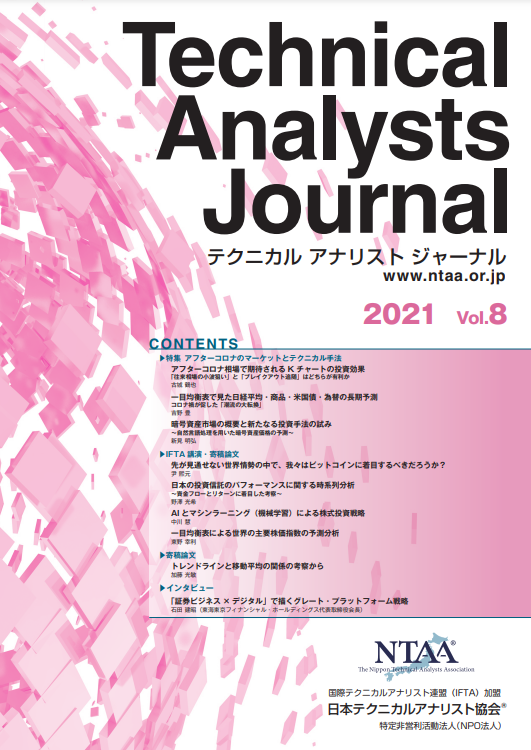We are thrilled to offer our international readers the NTAA’s Technical Analysts Journal Vol.8 2021 in Japanese language. The journal offers a wealth of information including trends, charts patterns. Please download your free copy by following instructions below.
For our international readers, we will highlight the abstracts of the main papers from NTAA Journal Vol.8 2021. Take a glimpse at the abstracts of the 5 topics below.

Don’t miss out the 2021 Technical Analysts Journal from NTAA (Nippon Technical Analysts Association). Download the journal now for free, and read about AI-Strategies, Bitcoin, trends and more from leading experts in the field.
Copyright © 2023 NTAA – The Nippon Technical Analysts Association. All rights reserved.
Abstracts (English language)
- In This Uncertain World Should We Focus on Bitcoin?
- Time-Series Analysis of the Performance of Japanese Mutual Funds ― A Study Focusing on Capital Flow and Return
- Stock Investment Strategies with AI and Machine Learning
- Predictive analysis of the world’s major stock indices using the Ichimoku Chart
- A Consideration of the Relationship between Trendlines and Moving Averages
In This Uncertain World Should We Focus on Bitcoin?
Author: Dr. Hiwon Yoon
(P. 29 – P. 34)
This paper explores the proposition: is it necessary to focus on the new market of Bitcoin?
“Now is the time to pay attention to Bitcoin” as a drawing conclusion, it consists of:
- Assessments made on the current market environment and price movements checked on the stock market, foreign exchange market, commodity market, and, the virtual currency, Bitcoin market.
- Highlights the misconceptions of many market participants and the author’s perspective offered.
- Introduces the analysis method of the Bitcoin market using AI and the follow-up comments made as to what has happened to the chart presented at the Malaysian Conference in 2018.
In order to gaze through the future, rather than expounding on past price movements, the technical analysis of Bitcoin. once again, needs to be explored.
Hiwon Yoon, PhD, CFTe, Vice President – Asia & Pacific of IFTA
Director of CMD Holdings Representative
Graduated from Keio University Graduate School of Science and Engineering.
Engaged in house account trading of Japanese and Asian stocks and derivatives at Solomon Brothers. From 2000 to 2007, he was a CMD Research Director focused on financial market analysis. In 2002, Ph.D. (Doctor of Engineering) from Keio University Graduate School of Science and Technology.
Established CMD Lab Co., Ltd. in 2007.
Established bitARG Co., Ltd. , a virtual currency exchange business, in 2017 and assumed the position of CEO.
Since 2019, Director at CMD Holdings Representative
Specializes in technical analysis of virtual currency, artificial intelligence, fintech, algorithmic trading, etc.
Co-authored “Econophysics of stock prices” and “New development of quantum walk”.
Time-Series Analysis of the Performance of Japanese Mutual Funds ― A Study Focusing on Capital Flow and Return
Author: Koki Nozawa
(P. 35 – P. 44)
In Japan, various system reforms have been carried out to encourage a shift from savings to asset building. When compared to Europe and the United States, while the ratio of “cash and deposits” in household financial assets in Japan is still high, the importance of self-help asset building is gradually spreading in order to prepare for retirement funds in an aging society.
With that backdrop, it is believed that the role played by investment trusts, facilitating “long-term, accumulation, and diversification” investment as a means of asset building, will continue to grow.
This paper, after confirming the major trend of Japanese open investment trusts in recent years, focuses on the fund flow and return of open investment trusts, and, utilizing time series analysis, analyzes all open investment trusts in Japan and per product category.
When the total net assets were broken down into the base price and the number of units, and the relationship between the fluctuation rate of the base price and the rate of change in the number of units was examined, it was found the explanatory power of the influence of the fluctuation rate of the base price in the previous month and the current month on the number of units in the current month was generally high. For example, it was observed that when the base price of “domestic stocks” rises (falls) in the current month, the number of units in that month decreases (increases) slightly due to contrarian selling (buying), and there is a tendency to trade based on short-term price movements.
In addition, for “global equities (unhedged)” and “composite”, it was observed that when the NAV of the previous month increased (decreased), the number of units increased (decreased) slightly in the current month due to trend buying (selling). They tended to be traded with a trend-following investment stance over a longer period than “domestic stocks”. It is conceivable that investors’ buying and selling stances may differ depending on the fund classification.
Koki Nozawa, MFTA
Works for Nikko Research Center Asset Management Research Institute,
Belongs to Fund Analyst Group at Nikko Research Center Asset Management Institute.
Researches, studies and provides information on asset management, performance analysis and domestic and foreign investment trust markets.
Stock Investment Strategies with AI and Machine Learning
Author: Dr. Kei Nakagawaa
P. 45 – P. 54
This paper explores how stock investment strategies can be constructed using AI by introducing two types of forecasting methods:
(1) focusing on stock price fluctuation patterns, which is the philosophy of technical analysis, and
(2) focusing on the factors underlying conventional quantitative analysis.
While AI and machine learning were different concepts originally, they are more interchangeable today.
Machine learning is an algorithm that mimics the functions of the human brain, and there are generally three types:
(1) unsupervised learning,
(2) reinforced learning, and
(3) supervised learning.
Learning means finding a model that can explain the data well.
Unlike image recognition and translation, what data to extract is important for predicting future stock prices. But, market data (technical data) being price and volume as such and economic and financial data (fundamental) being GDP and profit as such, it does not have predetermined characteristics, such as an image of a cat or “This is a pen” for translation.
There are two types in forecasting methods: time-series forecasting and cross-sectional forecasting.
Time series forecasting focuses on a single stock and forecasts future returns from historical data. On the other hand, cross-sectional prediction focuses on all stock prices and searches for stocks with high scores (=data and stock prices are linked) based on several criteria.
The purpose of time-series forecasting is to forecast absolute returns and investment periods are often short-term (shorter than months). On the other hand, cross-sectional forecasts project relative returns and are often long term (longer than months).
Kei Nakagawa, Ph.D.
Research Fellow, Advanced Technology Research Department, Nomura Asset Management
Graduated from Kyoto University with BA in Economics, and graduated from the University of Tsukuba Graduate School of Business Administration (MBA) and Ph.D.
At Sumitomo Mitsui Asset Management, engaged in fund risk management, domestic / overseas stocks, quantitative fund management / advice and model development of asset allocation. Since 2018, he has been working on research and development of advanced quantitative investment strategies that combine AI and big data at Nomura Asset Management Advanced Technology Research Department.
Many academic research papers on financial engineering, artificial intelligence, and machine learning.
Lectured at Tokyo Institute of Technology, University of Tsukuba, and Waseda University.
Predictive analysis of the world’s major stock indices using the Ichimoku Chart
Author: Yukitoshi Higashino
P. 55 – P. 61
The Ichimoku Chart is a market analysis method developed by Goichi Hosoda (1898-1982) through his many years of financial market research. The method is still widely used today, nearly 40 years after his death, by traders, investors, and analysts as an effective tool for market analysis and trading. Of late, Ichimoku Chart has also started to spread around the world, mainly in Asia, though it seems that the tool is not being used effectively. The reason is that the Ichimoku Chart integrates the principles and methods of multifaceted market analysis such as “price forecasting”, “time forecasting”, and “wave analysis”, making it extremely difficult to master completely.
Obviously, the Ichimoku Chart has the original text but the text comes with a big language barrier in overseas.
For Westerners, Japanese is a troublesome language in many ways, as it has a completely different vocabulary and grammatical structure.
Japanese to English translating is extremely difficult and matching a suitable English translation for the Japanese used in the original is a challenge.
This paper briefs on the text, based on the content that the author presented at the IFTA Cairo Conference in 2019.
Further, complemented with related theories, the original Japanese text translated in plain English is included, which is an excerpt from a contribution made to the IFTA Journal, published in 2020. Since it would be a considerable amount to publish everything, the paper only covers a basic part of the Ichimoku Chart and forecast analysis on the NY Dow, Shanghai Composite Index, and EGX30, which is the main index of Egypt, at the time of publication.
Yukitoshi Higashino, MFTA,
Chief Strategist DZH Financial Research
Born in Osaka in 1968.
Joined DZH Financial Research in 2006 after working at a securities company and a major bank.
Chairman of NTAA since June 2022 and serves as Director at the Board of IFTA.
In addition to presenting technical analysis papers at the IFTA Conferences in Europe and Egypt, he had been a part-time lecturer at Meiji University and Doshisha University.
Many media appearance on TV Tokyo, Nikkei CNBC, etc.
A Consideration of the Relationship between Trendlines and Moving Averages
Author: Mitsutoshi Kato
P. 67 – P. 74
In this paper, the author discusses the moving averages and trend lines, their trading rules and their relationship. They are the most familiar tools for us, technical analysts, and for those who are technical analysis enthusiasts. While, in recent years, with the advancement of personal computers and the Internet, it has become easier to access more and more complicated technical analysis, moving averages and trend lines are still the great standards in the world of technical analysis today and their strengths, perhaps, rest in their charm of simplicity.
Mitsutoshi Kato
Director EF&C Representative
Graduated from the Faculty of Law, Keio University, passing the judicial scrivener exam while in school.
After working at a judicial scrivener office and working as a company employee, established Ensemble Fund & Consulting Co., Ltd. and assumed the position of CEO.
A CMTA qualified business consultant.
He also holds the WSET Level 3 Award in Wines, an international wine certification.
Mainly in Ibaraki Prefecture, he holds investment seminars for individual investors, financial and economic seminars for the general public, asset management seminars for the elderly, and seminars for companies.
Supporter of the elderly and disabled, and facilitator of interactive museum visit.
Writes serialized “Anmitsu Sensei’s Blog” .
Copyright © 2023 NTAA – The Nippon Technical Analysts Association



